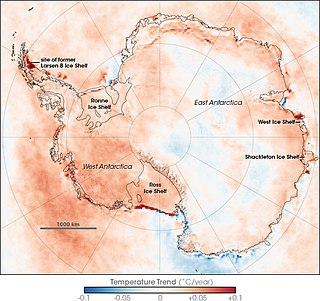Loading AI tools

The temperature record for Antarctica goes back only to 1950s, and consists of sparse network of stations, only some of which have a long, continuous period of observation. Most of the records that are available are from the Antarctic Peninsula or other coastal regions. In the entire interior of the continent, which is larger than Europe or the United States, there are only two stations (South Pole and Vostok) with decades-long periods of weather observations. In recent years automatic weather stations and meteorological satellites have started to help fill in the data gaps, but the temperatures derived from these may not be as reliable and their period of record is limited. These limitations have made it difficult to be certain about what, if any, long-term trends may be happening in Antarctica.
Climate models predict that, during this century, increasing greenhouse gas concentrations will cause temperatures in Antarctica to increase more than the global mean temperature, but less than those in the Arctic.[1] There has been a clear and significant warming on the Antarctic Peninsula over the last 50 years.[2][3][4] By contrast, studies published since 2002 looking at continent-wide temperature trends have produced less clear-cut results.[5][3][6][4] All of these studies report some cooling in Antarctica, and only one of them reports finding the overall
The continent-wide average surface temperature trend of Antarctica is positive and significant at >0.05°C/decade since 1957.[7][8][9][10]
The West Antarctic ice sheet has warmed by more than 0.1°C/decade in the last 50 years, and is strongest in winter and spring. Although this is partly offset by fall cooling in East Antarctica, this effect is restricted to the 1980s and 1990s.[11][12][13]
The British Antarctic Survey, which has undertaken the majority of Britain's scientific research in the area, has the following positions:
- Ice makes polar climate sensitive by introducing a strong positive feedback loop.
- Melting of continental Antarctic ice could contribute to global sea level rise.
- Climate models predict more snowfall than ice melting during the next 50 years, but models are not good enough for them to be confident about the prediction.
- Antarctica seems to be both warming around the edges and cooling at the center at the same time. Thus it is not possible to say whether it is warming or cooling overall.
- There is no evidence for a decline in overall Antarctic sea ice extent.
- The central and southern parts of the west coast of the Antarctic Peninsula have warmed by nearly 3°C. The cause is not known.
- Changes have occurred in the upper atmosphere over Antarctica.

The area of strongest cooling appears at the South Pole, and the region of strongest warming lies along the Antarctic Peninsula. A possible explanation is that loss of UV-absorbing ozone may have cooled the stratosphere and strengthened the polar vortex, a pattern of spinning winds around the South Pole. The vortex acts like an atmospheric barrier, preventing warmer, coastal air from moving in to the continent's interior. A stronger polar vortex might explain the cooling trend in the interior of Antarctica.
In their latest study (September 20, 2007) NASA researchers have confirmed that Antarctic snow is melting farther inland from the coast over time, melting at higher altitudes than ever and increasingly melting on Antarctica's largest ice shelf.[14]
There is also evidence for widespread glacier retreat around the Antarctic Peninsula.[15]
Wikiwand in your browser!
Seamless Wikipedia browsing. On steroids.
Every time you click a link to Wikipedia, Wiktionary or Wikiquote in your browser's search results, it will show the modern Wikiwand interface.
Wikiwand extension is a five stars, simple, with minimum permission required to keep your browsing private, safe and transparent.